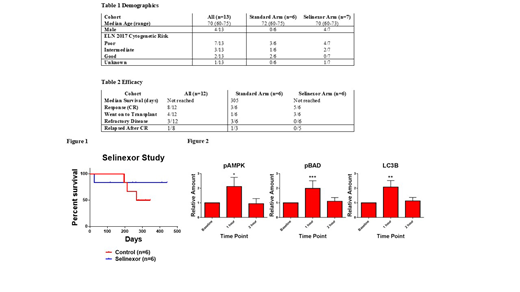
Background: Acute myeloid leukemia (AML) is an aggressive myeloid cancer of the hematopoietic system that primarily affects older adults and is characterized by therapy resistance and dismal outcomes. Novel approaches to treat AML are desperately needed. Selinexor is a small-molecule inhibitor of the nuclear export protein XPO1. Treatment of AML cells with selinexor was shown to sensitize them to chemotherapy in part by blocking the nuclear export of topoisomerase II, resulting in increased DNA strand breaks when an anthracycline is present. Furthermore, selinexor has shown encouraging results when combined with chemotherapy in the relapsed setting. This abstract reports on the initial results of a randomized phase II study of induction and consolidation with or without selinexor in newly diagnosed patients with AML 60 years of age or older.
Methods: Patients 60 years of age or older with newly diagnosed de novo AML were randomized between 7+3 or 7+3+selinexor induction. Responding patients could then go on to high dose cytarabine consolidation with or without selinexor as per their initial treatment assignment. Patients in the selinexor arm who completed all planned consolidation could then move to maintenance therapy with selinexor alone. During induction cytarabine was dosed at 100 mg/m2 by continuous infusion for 7 days and daunorubicin was dosed at 60 mg/m2 on days 1-3. In consolidation cytarabine was dosed at 1.5 gm/m2 given Q12 hours on days 1, 3 and 5. Selinexor was dosed at 60 mg PO on days 1, 3, 8, 10, 15 and 17 during induction and consolidation and on days 1 and 8 every 21 days in maintenance. Optional blood samples were collected just prior to and at several time points after selinexor during induction. Mononuclear cells were isolated from these samples, lysed and lysates evaluated for protein pathway drug target activation mapping by reverse phase phosphoprotein array (RPPA).
Results: Thirteen patients have been enrolled to date with 12 available for evaluation. Of the 12 evaluable patients 6 were randomized to each arm. Baseline demographics are listed in Table 1. Overall the combination was well tolerated with no patients discontinuing selinexor secondary to treatment related adverse events. In the standard arm 3 of 6 patients achieved a complete remission. Of the 3 responders 1 has relapsed, 1 has gone on to transplant and one has completed consolidation chemotherapy. In the selinexor arm 5 of 6 patients achieved a complete remission and 1 patient achieved a morphologic leukemia free state. All patients given selinexor achieved a response. Of the 5 responders 3 have gone on to transplant, 1 is on maintenance therapy (completed 14 cycles) and one is completing consolidation therapy. In the standard arm no patients died during induction and 3 of 6 patients have died from progressive disease. In the selinexor arm 1 patient died during induction and none of the remaining patients have progressed (Figure 1 and Table 2). No difference in the AE profile was noted between arms and no unexpected side effects were observed. The patient on long term maintenance selinexor is tolerating it without significant AEs to date. Blood samples were available from 3 patients from the selinexor arm. RPPA based protein pathway activation mapping analysis of PBMCs revealed a significant increase in phosphorylation of AMPK, BAD and LC3B at one-hour post treatment that returned to baseline by 2 hours suggesting a transient increase in these pathways that was subsequently suppressed (Figure 2).
Conclusions: Selinexor in combination with standard induction and consolidation therapy appears highly active in older de novo AML patients. Selinexor may increase response by modulation of AMPK, autophagy and BAD phosphorylation. Enrollment is ongoing.
Pardee:Spherix Intellectual Property: Research Funding; CBM Bipharma: Membership on an entity's Board of Directors or advisory committees; Amgen: Speakers Bureau; Celgene: Speakers Bureau; Pharmacyclics/Janssen: Speakers Bureau; Karyopharm: Research Funding; Rafael Pharmaceuticals: Consultancy, Research Funding. Manuel:Novartis: Speakers Bureau; Jazz Pharmaceuticals: Speakers Bureau. Powell:Pfizer: Consultancy, Research Funding; Rafael Pharmaceuticals: Consultancy, Research Funding; Novartis: Consultancy, Speakers Bureau; Jazz Pharmaceuticals: Consultancy, Research Funding, Speakers Bureau; Janssen: Research Funding.
Selinexor is not approved for the treatment of AML
Author notes
Asterisk with author names denotes non-ASH members.

This icon denotes a clinically relevant abstract


This feature is available to Subscribers Only
Sign In or Create an Account Close Modal